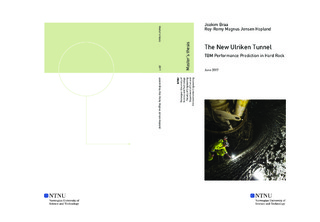| dc.description.abstract | A new railway tunnel through the mountain of Ulriken is constructed from Arna to Bergen, Norway. The tunnel project is named the New Ulriken Tunnel, and is constructed with a combination of drill and blast and Tunnel Boring Machine (TBM). This is the first time a TBM is used to construct a railway tunnel in Norway.
Consequently, this thesis is written in relation with the New Ulriken Tunnel with the main objective to study and compare different prediction models for TBM. Seven models were chosen, and will be presented and calculated individually. The different models are:
- The NTNU-model
- A model by Farrokh et al. (2012) presented in the journal Tunnelling and Underground Space Technology
- A model by Hassanpour et al. (2011) presented in the journal Tunnelling and Underground Space Technology
- The Gehring model
- The Apline model (modified Gehring)
- The QTBM-model
- The CSM- and MCSM-model (Modified CSM)
At last, the different results are compared towards each other as well as the achieved net penetration rate at the New Ulriken Tunnel. This comparison will give a deeper understanding of the models and how they behave with different input values.
The models require multiple input parameters, consisting of both machine and geological data. Thus, gathering field data at the New Ulriken Tunnel project has been a priority in this thesis. Over a period of eight weeks detailed mapping of the rock, various tests with the machine, and drilling of core samples were conducted. A 700-meter section of the tunnel was investigated, from TM 3775 TM 4475. In addition, TBM machine data was collected through an automatic logging system. This software logs every 10th second, providing a vast amount of data. After the collection of necessary data was completed, the in-situ samples were taken back to the laboratory and tested. The combination of the data was later put together and calculations of the different models were carried out.
Several spreadsheets are created in Microsoft Excel, creating a large amount of graphs and tables. The different spreadsheets display calculations and results for the geological investigation, TBM performance data, penetration- and RPM tests, chip analysis, and model performance predictions. The organization and calculations of this data in Excel have been a time-consuming activity. All results presented in this thesis are an outcome of this work.
All the used methodologies contain possible sources of error. Therefore, a thorough review of methodologies, calculations and results has been completed.
When all the needed parameters are established the prediction models can be calculated. The predicted net penetration rates from each model are compared to what has been achieved at the selected tunnel segment at the New Ulriken Tunnel. The results indicate that the model by Hassanpour et al. and the Alpine model show the most promising predictions. These models estimate net penetration rates very close to what has been achieved at the New Ulriken Tunnel. However, if a conservative result is more sought after, the Gehring model calculates the best values.
The study of the different models shows that cutter thrust, rock mass fracturing, and UCS are the machine and geological parameters most affecting the net penetration rate. It is therefore important that the models include these parameters to better reflect real situations.
Cutter ring life has been calculated using the NTNU-model. The estimations show good correlation with the actual cutter consumption while using achieved net penetration rates from the New Ulriken Tunnel.
The results in this thesis show that TBM prediction models are a good tool for project management. Predictions are relevant both for the early stages as well as during the construction of a project. However, more than one prediction model should be calculated to ensure a reliable result. | en |

